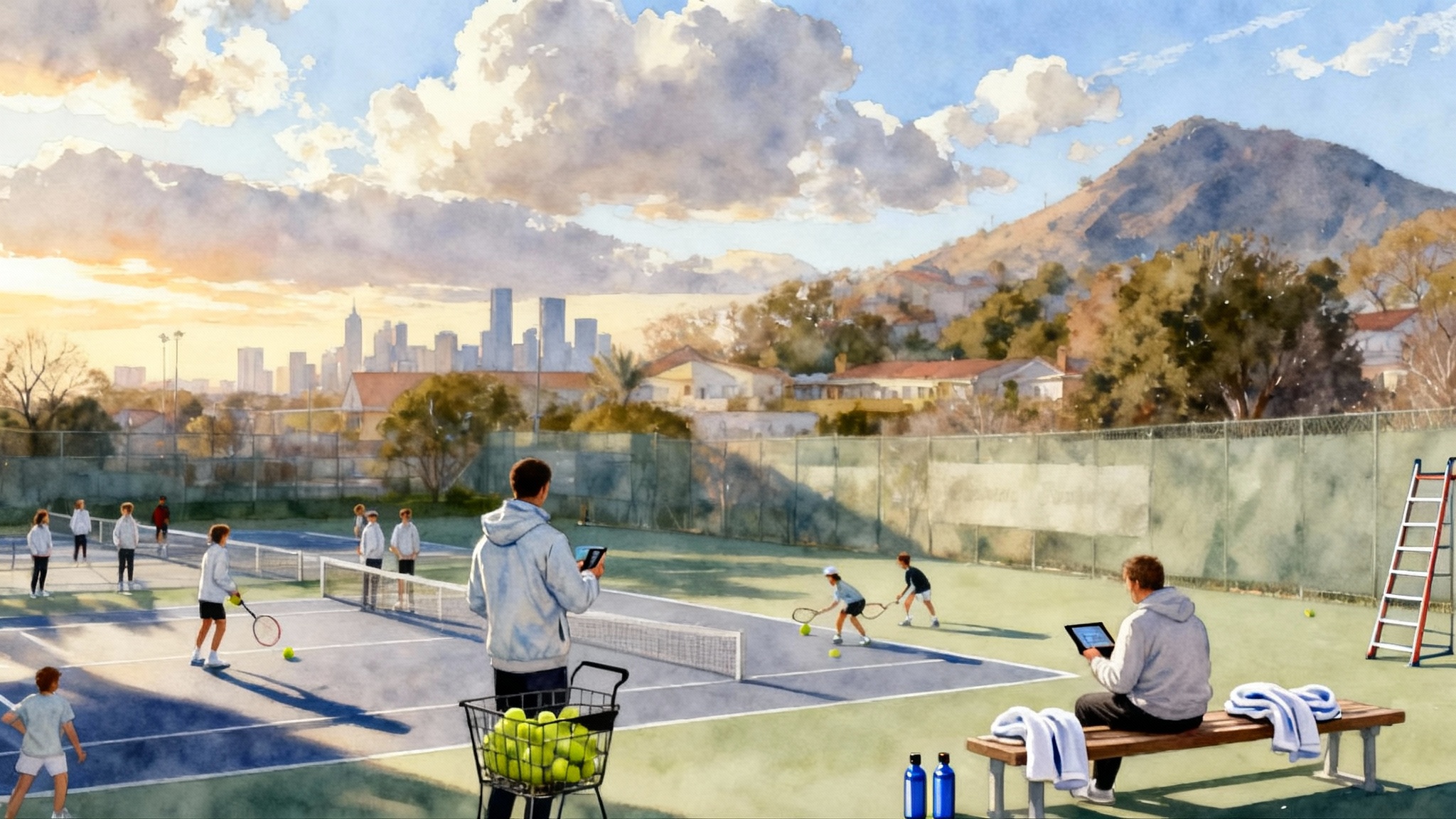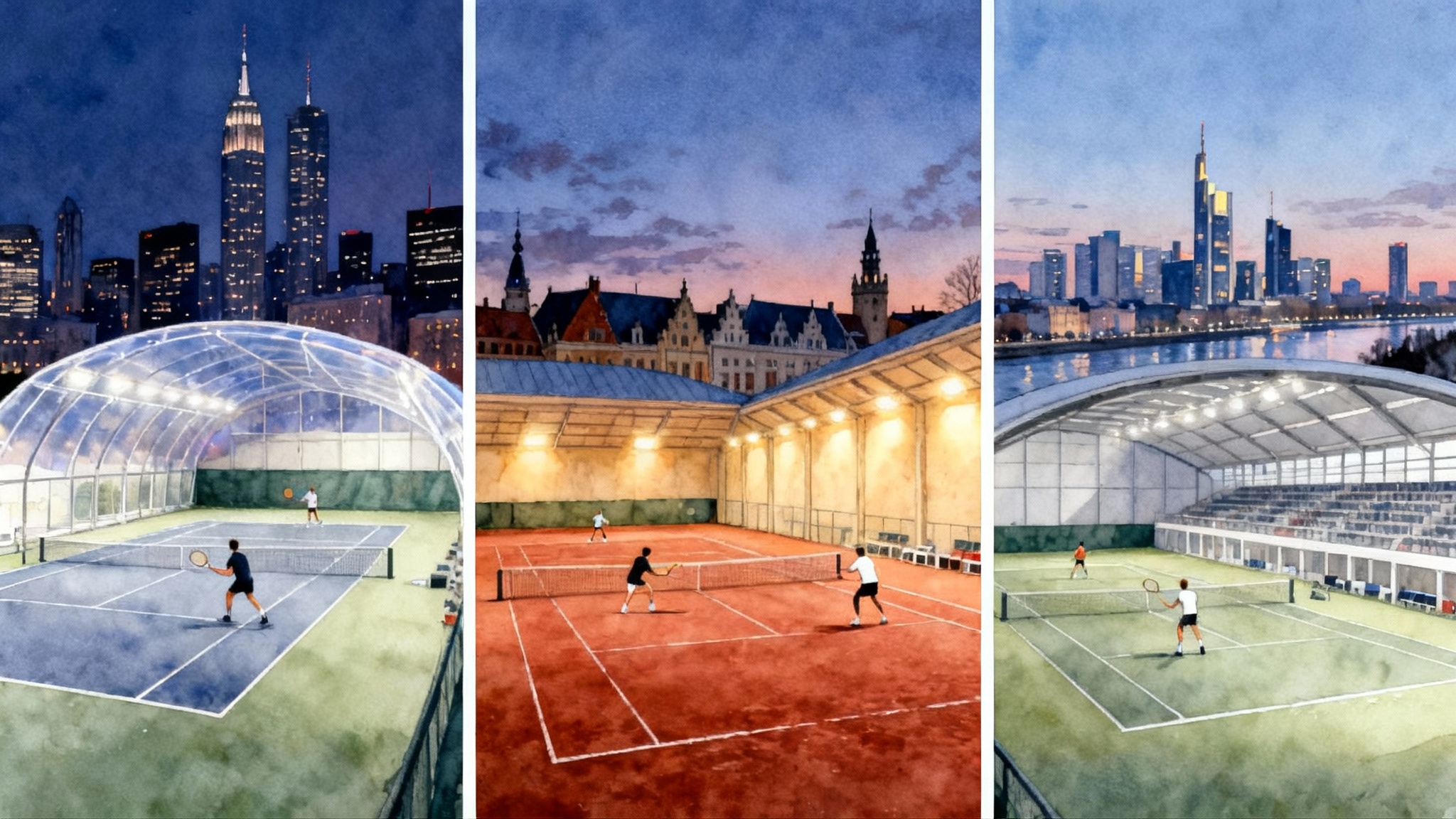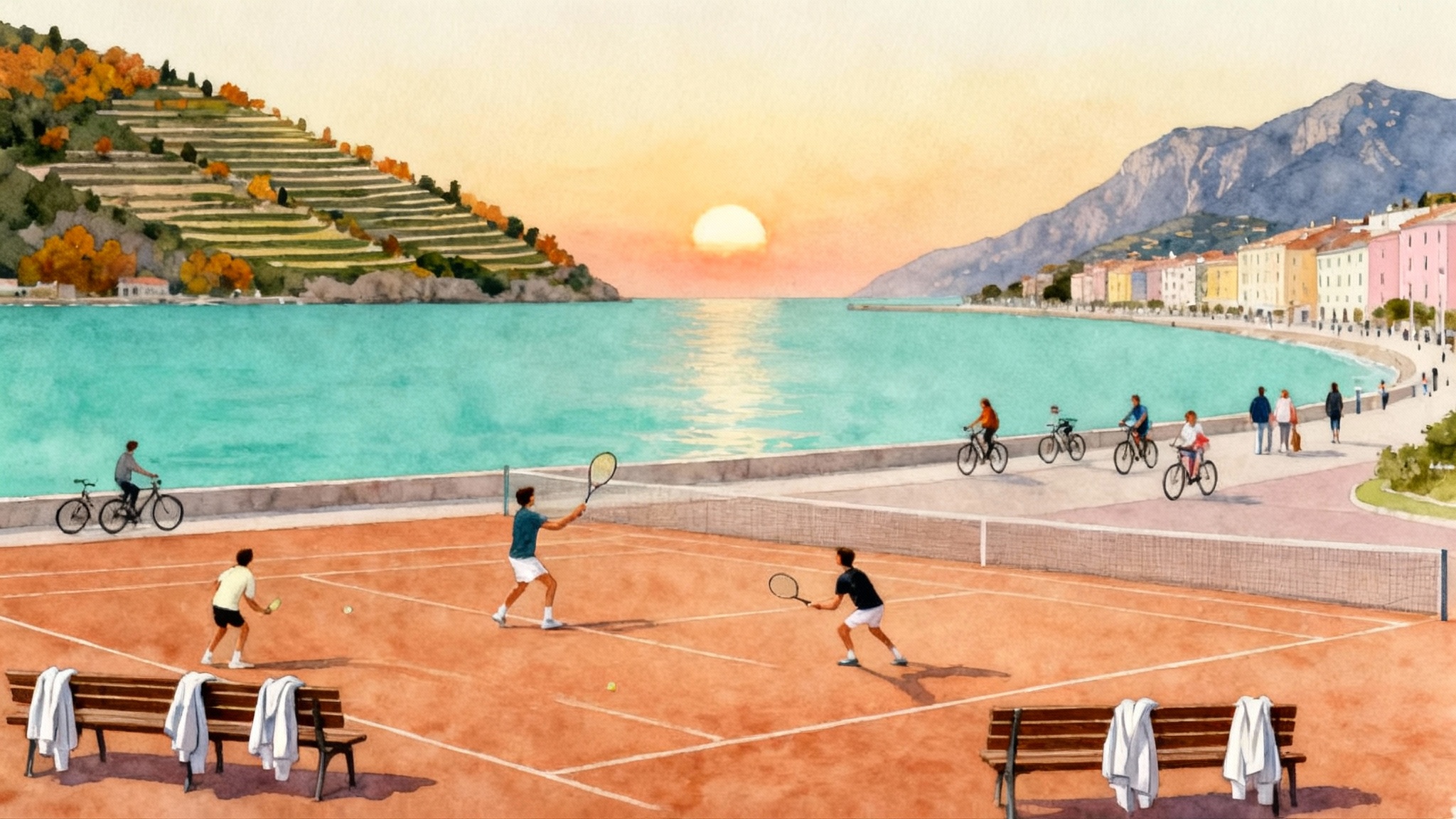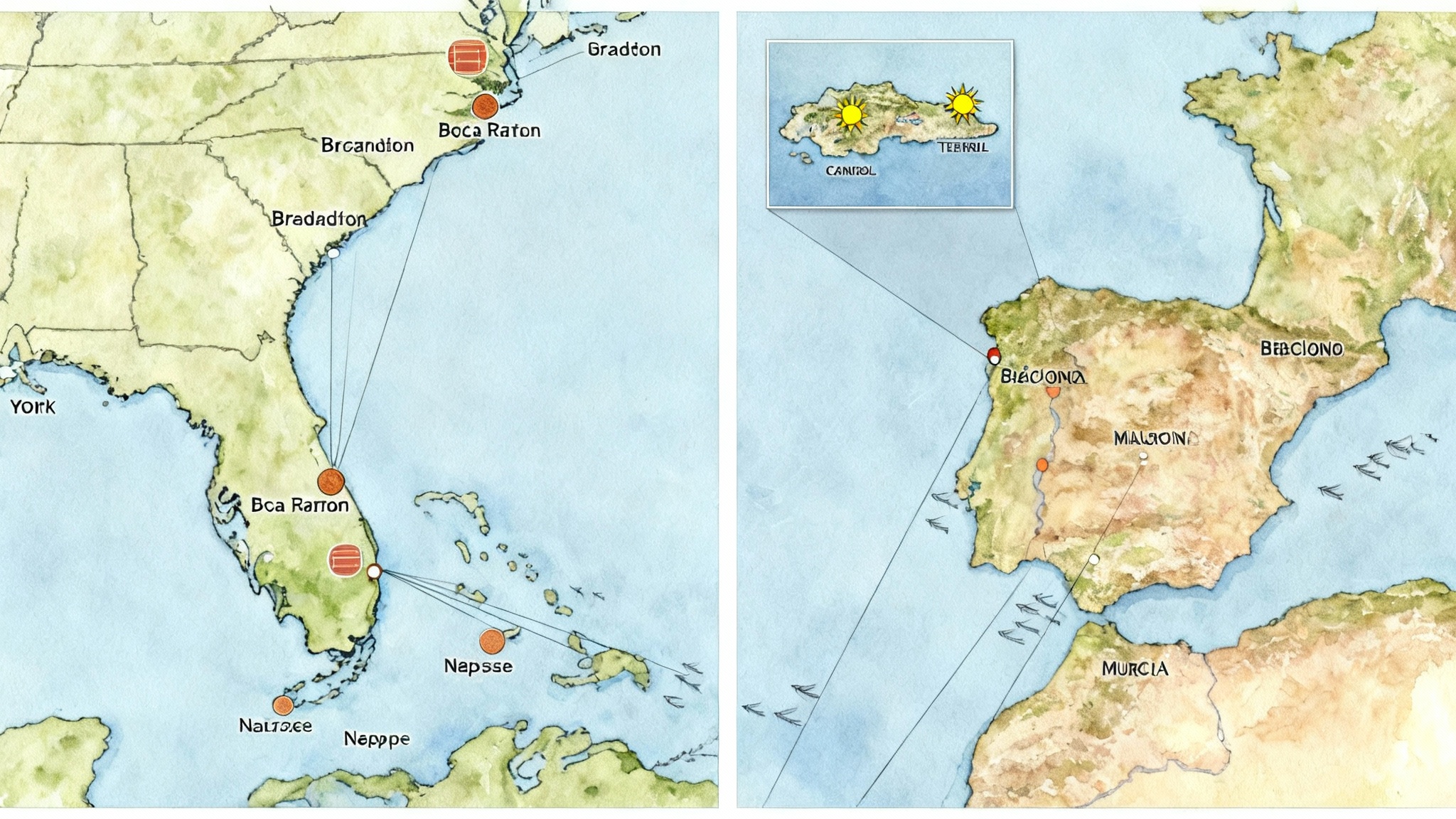Texas Winter Tennis: Houston’s Sleeper Base for December to March
If you want affordable training blocks between December and March, look past Phoenix and South Florida. Houston’s mild winter, indoor and outdoor court mix, and busy USTA calendar make it a quietly outstanding base for players and coaches.

Why Houston quietly outperforms classic winter bases
Sunseekers usually split into two winter camps: Phoenix for desert dryness or South Florida for tropical warmth. Houston does not get the same buzz, yet it checks three boxes that matter for training blocks from December through March: playable weather most days, a deep supply of courts and coaching, and a dense schedule of sanctioned play on weekends. Put those together and you get more reps, more matches, and usually a lower total cost. For broader context on winter choices, skim our Winter 2025 tennis training map.
Houston winters are mild. A typical December or January day starts cool enough for a light layer, then warms into the low or mid 60s Fahrenheit by lunchtime, with many afternoons in the 70s by March. The city sees humidity that keeps balls lively without turning every session into a sweat fest. Average wind is moderate, so you can work on serve targets and touch volleys without fighting constant gusts. Phoenix is drier with fewer rain days but can be cooler on crisp mornings. South Florida is warmer, yet fronts can bring stiff onshore winds that chop up the ball toss. The result is that Houston gives you a large share of sessions that feel like match conditions.
If you prefer numbers, the broad picture looks like this based on long term climate normals from the National Oceanic and Atmospheric Administration: winter in Houston brings moderate wind, mid to high relative humidity, and six to nine wet days per month, while Phoenix brings lower humidity and two to four wet days, and South Florida brings warmer air with similar humidity to Houston and five to seven wet days. Use the normals as direction, then plan buffers into your week. For underlying definitions and the 1991 to 2020 methodology, see the NOAA U.S. climate normals overview.
The training effect of wind, humidity, and rain days
-
Wind: Moderate wind is a coach’s friend. In Houston you can still run precision drills and serve targets without redesigning the entire plan. In Phoenix, calm mornings are common, which is great for technical rebuilds. In South Florida, winter fronts sometimes spike sustained wind, which helps build heavy ball skills but can distort timing work if it lasts all day. The practical move in Houston is to plan a spin and feel block on the breezier day and save edge precision for calmer mornings.
-
Humidity: Air density affects ball speed. Houston and South Florida keep the felt a touch heavier than Phoenix, which helps players feel the ball on the strings and build fitness without extreme heat. Phoenix’s low humidity makes the ball fly, which is great for confidence in offense and for serve pop, but sometimes hides footwork flaws. Rotate environments when you can, but if your priority is match realism at sea level, Houston is a strong middle ground.
-
Rain days: Phoenix wins for fewest rain days. Houston and South Florida have more passing showers, but Houston’s pop up rain is often short. Most public centers and clubs in Houston dry courts quickly, and many have at least a few covered or wind screened courts that come back online first. Build a gym and film session into your plan as insurance.
Indoor and outdoor options that keep a week on track
Houston is an outdoor first city for tennis, with dozens of public hard courts across the metro and many lighted for evening play. Several private clubs maintain covered or semi covered courts, and a few indoor options exist within driving distance for true rain outs. That mix matters. You can front load your week with outdoor drilling and match play, then pivot to a covered late afternoon session if weather turns. Coaches running small groups often book a block of outdoor courts and keep one covered court in reserve for technical filming or serve work.
Why the USTA calendar density matters
From December to March, weekends in Greater Houston reliably feature sanctioned options for juniors and adults. Expect a mix of junior Levels 6 and 7, universal tennis rating events that publish draws in advance, and adult division play, often within a 30 to 60 minute drive from central neighborhoods. The practical benefit is simple. You can plan a Tue to Fri training block, step into real matches on Saturday and Sunday, then fly home or reset for week two. To scan upcoming events and filter by location, month, and division, use the USTA Play Tennis tournament search.
Cost dynamics: where Houston saves you money
- Courts: Public centers in Houston are abundant, which holds down reservation fees. Private clubs offer guest access for clinics and drills at prices that are usually lower than resort towns.
- Flights: Two major airports serve the city, which keeps airfare competitive. Southwest, United, and several budget carriers offer multiple daily routes.
- Hotels: Standard business hotels dominate the market in central and suburban hubs. Weeknight corporate pricing often beats leisure destinations in winter.
The result is that you can allocate more of your budget to coaching hours and stringing rather than to travel overhead. That means more ball strikes for the same spend.
Head to head weather comparison in practice
Think in terms of training outcomes rather than perfect averages.
- Technical rebuilds: Phoenix is excellent for pure stroke work because of dry air and fewer rain interruptions. Houston is nearly as reliable, with slightly more humidity that helps players feel the ball. South Florida works too, but wind fronts can eat entire mornings.
- Match realism at sea level: Houston and South Florida both deliver this. If you plan to compete in most U.S. cities at low altitude, these are the right environments. Houston’s wind profile tilts steadier on average in winter.
- Fitness blocks: Houston’s cool mornings and mild afternoons let you pair footwork ladders with live ball drilling without extreme heat stress. Phoenix requires more hydration strategy due to dry air. South Florida requires heat management on warmer days.
Five to seven day itineraries you can copy
Below are plug and play outlines. Swap in rest and sightseeing where you want, but keep the morning intensity and afternoon purpose.
Adult performance, 5 days (Mon to Fri)
- Day 1 Monday: Arrival morning. Noon equipment check and movement screen. Afternoon 90 minutes of serves and first ball patterns. Evening easy match play to test patterns.
- Day 2 Tuesday: Morning two hour technical session on forehand and backhand height control. Afternoon 60 minutes of return plus one combos. Evening video review.
- Day 3 Wednesday: Morning live ball point construction with targets. Afternoon 45 minutes of footwork intervals and 30 minutes of serves to spots. Optional sports massage.
- Day 4 Thursday: Morning doubles drills for returns through middle and poach timing. Afternoon tie break sets with different tactical constraints. Evening grip and string check.
- Day 5 Friday: Morning match play set followed by pressure games. Afternoon short hit, debrief, and travel.
Adult performance, 7 days (Sat to Fri)
- Day 1 Saturday: Arrive and loosen up. 60 minute hit to groove contact.
- Day 2 Sunday: Morning baseline depth control. Afternoon serves and returns. Early night.
- Days 3 to 5 Monday to Wednesday: Mornings are high intensity technical blocks. Afternoons are pattern rehearsals and set play. One evening doubles clinic to sharpen net reads.
- Day 6 Thursday: Ladder fitness test in the morning. Afternoon match play with video on key points.
- Day 7 Friday: Recovery mobility, short hit, and travel.
Junior tournament prep, 5 days (Tue to Sat)
- Day 1 Tuesday: Morning stroke spacing and contact tolerance. Afternoon match play for 8 to 10 games with serve targets between changeovers.
- Day 2 Wednesday: Morning plus one patterns and defensive depth. Afternoon serve and return ladders with charting.
- Day 3 Thursday: Morning point building off second serve. Afternoon supervised sets with scouting on likely weekend opponents if draws are published.
- Day 4 Friday: Morning match play simulation with constraints and pressure tiebreaks. Afternoon light hit and mobility. Early night.
- Day 5 Saturday: Tournament day one. Warm up with tempo drills. Match. Cool down and notes.
Junior tournament prep, 7 days (Mon to Sun)
- Day 1 Monday: Baseline assessment and goals. Two hour technical block on neutral ball depth.
- Day 2 Tuesday: Serve and first forehand shapes. Afternoon match play with charting.
- Day 3 Wednesday: Defensive skills and transition. Short volley lab. Evening video review.
- Day 4 Thursday: Fitness day with on court intervals and medicine ball work. Short hit to confirm timing.
- Day 5 Friday: Tactical rehearsal sets with scoreboard pressure.
- Day 6 Saturday: Tournament match one. Recovery session and light hit.
- Day 7 Sunday: Tournament continuation or practice sets with objectives.
Hotel and club pairings that make logistics easy
Houston is a big metro, so cut commute time by pairing a hotel hub with nearby courts.
- Galleria and Memorial Park: Stay near Uptown for quick access to Memorial Park Tennis Center and several private academies along Loop 610. The Westin Galleria and Hyatt Place near the Galleria keep you within a 10 to 15 minute drive of central courts.
- Rice Village and West University: Hotels near the Texas Medical Center and Rice Village put you close to multiple public and private facilities, plus food you can walk to between sessions. Think simple, business class hotels with breakfast included so you can get on court by 8 a.m.
- The Woodlands and Spring: If you plan to anchor around Giammalva Racquet Club, stay in The Woodlands Town Center. The Marriott Waterway and Hyatt Place The Woodlands give you short drives and easy dining.
- Westchase and Energy Corridor: For value pricing and easy access to west side courts, base in Westchase. You will trade a bit more driving for lower rates.
Tip: book a hotel with free parking and a mini fridge. Prepping hydration and snacks is easier, and you save time between morning and afternoon sessions.
Spotlight: Houston Tennis Academy
See the Houston Tennis Academy profile for programs and facilities. This member based junior pathway blends live ball intensity with technical checkpoints and a clear USTA progression. A structured Tuesday to Friday program pairs a morning build session with an afternoon match set and tactical debrief. If you are visiting, inquire early about group size, surfaces, and whether Universal Tennis Rating verified match sets can be arranged.
Spotlight: Giammalva Racquet Club
The Giammalva Racquet Club academy profile covers the setup in Spring, just north of Houston. Adult weeks often combine morning clinics that emphasize footwork and first strike patterns with afternoon supervised match play. The club’s lighted hard courts and pro shop make it easy to add an evening serve session or grab a fresh string job midweek. For juniors, the club offers group practices that scale from fundamentals to tournament prep. When you need a quieter court for film or serve work, staff can usually point you to the right time window.
A sample 5 day schedule at Giammalva for adults looks like this:
- Monday: Technical rebuild on forehand height and spacing, then serves to body and T.
- Tuesday: Return of serve lab, transition footwork, and first volley drills.
- Wednesday: Live ball crosscourt to down the line change, then short sets.
- Thursday: Doubles focus with return through middle, poach timing, and signals.
- Friday: Match play with scoreboards and between point routines.
If you want to blend days at Giammalva with central Houston sessions, plan one or two north side days to reduce driving, then anchor in central Houston for the rest.
How to build your Houston week
- Define the goal: Technical rebuild, tournament prep, or fitness. Pick one primary pillar so your sessions stack.
- Map the calendar: Choose a week that ends with a tournament or league play day. That turns training into feedback.
- Book morning courts first: Reserve 8 to 10 a.m. daily slots for your most technical work while wind and traffic are low.
- Layer coaching: Secure a coach or clinic for three mornings, and leave two mornings for self led drills or ball machine reps.
- Pre wire rain insurance: Identify a nearby covered court or a gym for strength and mobility. Put the address in your calendar so you do not lose time if weather shifts.
- Plan stringing: Bring two frames and set a midweek string window. Humidity can change feel, so be ready to adjust tension.
- Add match play: Slot sets on Tuesday and Thursday afternoons. If you are prepping for a weekend event, taper Friday to a 60 minute hit and mobility.
Sample weekly budgets
Budgets vary, but a realistic adult single week plan in Houston can include five morning courts, three coaching clinics, two supervised match sessions, and a weekend event entry at a total cost that is often lower than comparable weeks in South Florida resort markets. You also save by using standard business hotels and by flying midweek. Juniors can layer a similar mix, substituting one or two clinics with group academy blocks that include charting and film.
What to pack for winter Houston
- Light layers: Start in a long sleeve top, shed to a tee by late morning.
- Non slip overgrips: Humidity changes grip feel. Rotate fresh overgrips daily.
- Two pairs of shoes: Courts can be damp early after overnight dew. Alternate pairs to keep traction.
- Small towel and a soft hat: Manage sweat and low winter sun angles.
- A foam roller and mini band: Keep mobility high when you add volume.
Phoenix or South Florida instead
If your technical priority is maximizing dry air and you want as few rain days as possible, Phoenix is a great call. If you want warmer air and do not mind wind risk on front days, South Florida can be ideal. If you want a middle path that reduces price, preserves match realism, and keeps a busy weekend calendar, Houston is hard to beat.
The bottom line
A good winter base lets you stack high quality sessions without wasting days on logistics or weather. Houston gives you mild temperatures, manageable wind, a deep bench of coaches, and sanctioned play most weekends from December to March. Set the week, stick to the plan, and you will leave with better patterns and a clearer match identity at a lower cost than the usual winter hot spots.


